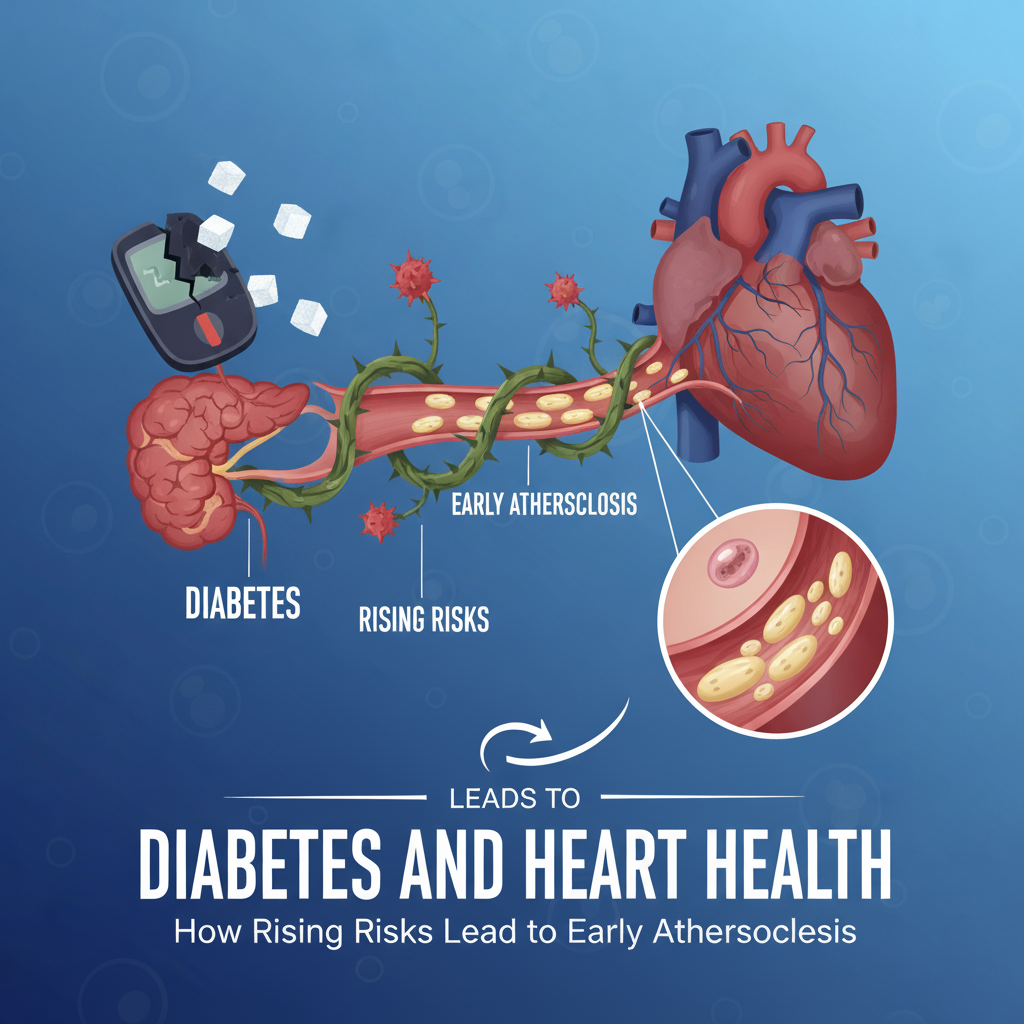Diabetes and Heart Health: How Rising Risks Lead to Early Atherosclerosis
Introduction:
Over the past few decades, diabetes has emerged as one of the fastest-growing health concerns worldwide. Once considered a condition of older adults, High blood sugar is now appearing in younger people, including those in their 20s and 30s.
The concern goes beyond blood sugar levels. This chronic condition damages blood vessels and speeds up atherosclerosis, a buildup of plaque in the arteries. As a result, many young adults face an increased risk of heart disease much earlier than expected.

What is Diabetes and How It Impacts the Body
According to Wikipedia, diabetes is a metabolic disorder where the body struggles to produce or properly use insulin. Insulin is essential for regulating glucose, and when it doesn’t function correctly, high blood sugar levels occur.
This imbalance gradually harms blood vessels in several ways:
- Weakens artery walls
- Encourages plaque buildup
- Increases inflammation
Together, these changes accelerate arterial narrowing, making diabetes one of the strongest risk factors for heart disease and stroke.
Why Young Adults Are Increasingly at Risk
- Earlier Diagnoses
- High blood sugar is now being identified at much younger ages.
- Early onset means artery damage begins earlier in life.
- Silent Progression
- Elevated blood sugar may quietly damage arteries for years before symptoms show.
- By the time warning signs appear, plaque buildup may already be advanced.
- Obesity and Insulin Resistance
- Excess weight worsens insulin resistance, raising the chance of long-term cardiovascular complications.
- Obesity combined with diabetes significantly increases risk of heart attacks.
The Connection Between Diabetes and Atherosclerosis
The link between diabetes and atherosclerosis is well established:
- High blood sugar makes artery walls “sticky,” trapping cholesterol.
- Insulin resistance raises bad cholesterol (LDL) while lowering good cholesterol (HDL).
- Ongoing inflammation from glucose imbalance accelerates plaque formation.
This explains why people with High blood sugar are more prone to cardiovascular complications even if they are otherwise young and active.
Early Warning Signs to Watch Out For
Though often silent, some warning signs should not be ignored:
- Persistent fatigue
- Tingling or numbness in extremities
- Chest pressure or heaviness
- Shortness of breath during exertion
- Leg pain while walking
These may indicate reduced blood circulation and warrant medical evaluation.
Prevention: Reducing Heart Risks Linked to Diabetes
- Blood Sugar Management
- Monitor glucose levels regularly.
- Follow medical advice for diet, medication, or insulin therapy.
- Balanced Nutrition
- Favor whole grains, vegetables, lean proteins, and healthy fats.
- Cut down on sugary beverages and ultra-processed foods.
- Physical Activity
- Aim for 30 minutes of moderate exercise daily.
- Walking, cycling, and swimming improve circulation and insulin sensitivity.
- Lifestyle Choices
- Quit smoking, limit alcohol, and manage stress.
- Prioritize good sleep for metabolic health.
- Regular Health Screenings
- Routine checks for cholesterol, blood pressure, and glucose help detect issues early.
- Modern imaging can identify subclinical atherosclerosis before major symptoms appear.
The Bigger Picture
Diabetes is more than just a condition of blood sugar—it is a systemic health challenge with significant cardiovascular consequences. The rise of this metabolic disorder among young adults is a warning sign that prevention and education are more important than ever.
Conclusion
The connection between diabetes and atherosclerosis shows why managing this condition is essential for protecting long-term heart health. With timely diagnosis, consistent glucose control, and healthy lifestyle habits, it is possible to reduce risks significantly.
At Dr. Vrishit Saraswat, patients receive expert care, from advanced diagnostics to minimally invasive treatments, for managing diabetes-related cardiovascular risks.
👉 Take charge of your health today—because prevention starts with managing diabetes effectively






